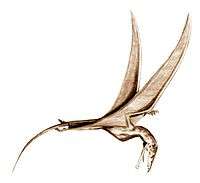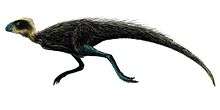Anchisaurus
| Anchisaurus Temporal range: Early Jurassic, 190–174 Ma | |
|---|---|
 | |
| Life restoration | |
| Scientific classification | |
| Kingdom: | Animalia |
| Phylum: | Chordata |
| Class: | Reptilia |
| Clade: | Dinosauria |
| Order: | Saurischia |
| Suborder: | †Sauropodomorpha |
| Clade: | †Anchisauria |
| Family: | †Anchisauridae Marsh, 1885 |
| Genus: | †Anchisaurus Marsh, 1885 |
| Species: | †A. polyzelus |
| Binomial name | |
| Anchisaurus polyzelus (Hitchcock, 1865) | |
| Synonyms | |
| |
Anchisaurus is a genus of basal sauropodomorph. An early herbivorous dinosaur,[1] it lived during the Early Jurassic Period; more specifically, the Pliensbachian to Toarcian ages, 190 to 174 million years ago. Until recently it was classed as a member of Prosauropoda. The name comes from the Greek αγχι/agkhi anchi-; "near, close" + Greek σαυρος/sauros; "lizard", probably referring to Marsh's interpretation of it as intermediate between primitive dinosaurs (at the time Palaeosaurus was an example of what was thought to be a primitive dinosaur) and more derived dinosaurs. Anchisaurus was coined as a replacement name for Amphisaurus, which was itself a replacement name for Hitchcock's Megadactylus, both of which had already been used for other animals.
Hitchcock collected these bones under the name Megadactylus in 1865. However, the name was already in use, and paleontologist Othniel Charles Marsh renamed it Anchisaurus in 1885. Remains thought to belong to this genus were found in South Africa and China, adding to the theory that these land masses were at the time joined in one super-continent, Pangaea, but these assignments have been contentious (Gyposaurus). A recovery from Nova Scotia may also be an Anchisaurus but this is unconfirmed.
Description

Anchisaurus was a rather small dinosaur, with a length of just over 2 metres (6.6 ft), which helps explain why it was once mistaken for human bones.[2] It probably weighed around 27 kilograms (60 lb). However, Marsh's species A. major (also known as Ammosaurus) was larger, from 2.5 to 4 metres (8 ft 2 in to 13 ft 1 in) and some estimates give it a weight of up to 70 pounds (32 kg). Gregory S. Paul estimated its length at 2.2 meters and its weight at 20 kg in 2010.[3]
Behaviour and diet
Digesting plant matter is a much more intensive biochemical process than digesting meat. This herbivore swallowed gastroliths (gizzard stones) to help break down the food in its stomach.[1] Herbivorous dinosaurs needed a huge gut. Since this had to be positioned in front of the pelvis, balancing on two legs became increasingly difficult, as dinosaurs became larger and they gradually evolved into the quadrupedal position that characterizes the later sauropods such as Diplodocus.[4] Prosauropods represented a middle phase between the earliest bipedal herbivores and the later giant sauropods. Although it was not itself a prosauropod, Anchisaurus was mostly typical of this group, which flourished briefly during the late Triassic and early Jurassic. Anchisaurus teeth, used to rip food, were shaped like spoons.[1] It had fewer and more widely spaced teeth than true prosauropods, and as Peter Galton and Michael Cluver observed, narrower feet.[2] Anchisaurus would have spent most of its time on four legs but could have reared up on its hind legs to reach higher plants.
On the other hand, some paleontologists believe Anchisaurus may also have eaten meat, as it was in the transition between these two ultimately distinct groups. The teeth were blunt but with file-like edges, suggesting mostly plant matter was eaten and the jaw hinge was arranged in a way not entirely suited for tearing meat. Nevertheless, there is still some debate. The thumb had a large claw and the large eyes were not entirely on the side (as would be expected in an animal of a natural prey species).
As a quadrupedal/bipedal crossover, Anchisaurus had to have multi-purpose front legs. As 'hands', they could be turned inwards and be used for grasping. It had a simple reversible first 'finger', similar to a 'thumb'. As feet, the five toes could be placed flat against the floor and were strong at the ankle. This unspecialized design is typical of the early dinosaurs.
Discovery

Sauropodomorph remains were first discovered in North America in 1818, when some large bones were discovered by Mr. Solomon Ellsworth while excavating a well in East Windsor, Connecticut. At the time of their discovery the bones were assumed to be those of a human,[5] but the presence of tail bones quickly falsified that idea and they are now recognized as those of an indeterminate sauropodomorph, possibly more closely related to the plateosaurian prosauropods.[6][7] In 1857 the type specimen of Anchisaurus polyzelus, which is housed at the Amherst College Museum of Natural History, was found by William Smith in Springfield, Massachusetts during blasting for a well at the Springfield Armory.[8] Unfortunately, both the East Windsor and Springfield specimens were severely damaged due to the blasting at the construction sites where they were found, and many of the bones were either accidentally thrown away by the workmen or kept by interested onlookers.[8][9] Thus these dinosaurs were only known from incomplete remains. Luckily, in 1884 nearly complete specimens were found in Manchester, Connecticut[10] and served as the templates from which O.C. Marsh restored the skeleton.[11] The Manchester specimens are now considered conspecific with Anchisaurus polyzelus.[12] The East Windsor and Manchester specimens are housed at the Peabody Museum of Natural History at Yale University.
Classification

Due to its primitive appearance, Anchisaurus was previously classified as a prosauropod, a member of a group of animals related to or ancestral to the sauropods. Recent investigations show that a group of traditional prosauropods form a monophyletic sister-group to Sauropoda, and that Anchisaurus is instead closer to sauropods.[13]
Marsh was originally happy with Hitchcock's name Megadactylus[14] but this name was already taken. Therefore, he renamed it Amphisaurus in 1882. However, this name was also already in use and therefore, it became Anchisaurus in 1885.
The type species is Hitchcock's A. polyzelus. Marsh's A. major ("greater near lizard") is still often considered a valid species (as Ammosaurus) but his A. colurus (1891), once known as Yaleosaurus (von Huene, 1932), is now generally accepted as a female A. polyzelus, and his A. solus of 1892 is now reclassified as Ammosaurus major. However, Ammosaurus major itself may well be a synonym of A. polyzelus.
Broom named Gyposaurus capensis in 1911, from the bones discovered in South Africa but Peter Galton officially renamed it A. capensis in 1976. This species has since been reclassified again and is probably a juvenile of Massospondylus carinatus. G. sinensis was also referred here, but appears to be a distinct animal. Other specimens are still awaiting reclassification. This confusion is typical of the first dinosaurs to be discovered, when classification was not considered as important and precise a process as today.
The family Anchisauridae was first proposed by Othniel Charles Marsh in 1885 and later defined as a clade consisting of Anchisaurus and its nearest relatives. However, it is not clear which other genera are included in the family; many of the dinosaurs once included have since been moved elsewhere, and the group is not used in most current taxonomies.[13]
References
- 1 2 3 Gaines, Richard M. (2001). Coelophysis. ABDO Publishing Company. p. 14. ISBN 1-57765-488-9.
- 1 2 "Anchisaurus." In: Dodson, Peter & Britt, Brooks & Carpenter, Kenneth & Forster, Catherine A. & Gillette, David D. & Norell, Mark A. & Olshevsky, George & Parrish, J. Michael & Weishampel, David B. The Age of Dinosaurs. Publications International, LTD. p. 27. ISBN 0-7853-0443-6.
- ↑ Paul, G.S., 2010, The Princeton Field Guide to Dinosaurs, Princeton University Press p. 163
- ↑ Palmer, D., ed. (1999). The Marshall Illustrated Encyclopedia of Dinosaurs and Prehistoric Animals. London: Marshall Editions. p. 122. ISBN 1-84028-152-9.
- ↑ Smith, Nathan (1820). "Fossil bones found in red sandstones". American Journal of Science. 2: 146–147.
- ↑ Galton, Peter (1976). "Prosauropod dinosaurs (Reptilia: Saurischia) of North America". Postilla. 169: 1–98.
- ↑ Yates, Adam (2004). "Anchisaurus polyzelus (Hitchcock): The smallest known sauropod dinosaur and the evolution of gigantism among sauropodomorph dinosaurs". Postilla. 230: 1–57.
- 1 2 Hitchcock, Edward (1858). Ichnology of New England. Boston: William White.
- ↑ Hitchcock, Edward (1841). Final Report on the Geology of Massachusetts. Volume 2. Containing III Scientific Geology. IV Elementary Geology. Amherst and Northampton: J.S. & C. Adams, J.H. Butler.
- ↑ Marsh, O.C. (1889). "Notice of New American dinosauria". American Journal of Science. 37: 331–336.
- ↑ Marsh, O.C. (1893). "Restoration of Anchisaurus". American Journal of Science. 45: 169–170. doi:10.2475/ajs.s3-45.266.169.
- ↑ Yates, Adam (2010). "A revision of the problematic sauropodomorph dinosaurs from Manchester, Connecticut and the status of Anchisaurus Marsh". Palaeontology. 53: 739–752. doi:10.1111/j.1475-4983.2010.00952.x.
- 1 2 Yates, Adam M. (2010). "A revision of the problematic sauropodomorph dinosaurs from Manchester, Connecticut and the status of Anchisaurus Marsh". Palaeontology. 53 (4): 739–752. doi:10.1111/j.1475-4983.2010.00952.x.
- ↑ E. Hitchcock. 1865. Appendix [A]. Bones of Megadactylus polyzelus. Supplement to the Ichnology of New England. A Report to the Government of Massachusetts in 1863. Wright and Potter, Boston 39-40
| Wikispecies has information related to: Anchisaurus |
| Wikimedia Commons has media related to Anchisaurus. |



